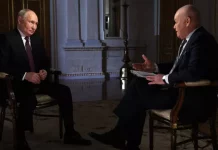Force, money and information are the three vectors of Russia’s attack on the West. Each makes the other more effective.

Edward Lucas, for CEPA
The targets range from individuals to nation-states. Assassination, poisoning, beatings and burglary are examples of the force vector at the “micro” level. So are blackmail and extortion.
At the macro level, Russia lacks the Soviet Union’s military might. But it deploys what it has in an effective manner. Its military saber-rattling is not designed to show that it could beat NATO in a full-scale confrontation: it could not. But the snap exercises and other drills, especially involving air-defense systems and small nuclear weapons, do signal that Russia is ready to escalate quickly. For many in the West, who have drunk deep from the post-1991 complacency teat, such a risk is simply not worth taking.
Here again the vectors overlap: force plus propaganda equals intimidation.
These vectors also combine well in the “hacking and leaking” attacks seen in American politics last year (and expected in European elections this year). Stealing private data from a computer network is not that different from breaking into an office: both are crimes. But they don’t have much effect unless the data are used. Publishing the stolen material, either directly or by giving it to media outlets, is what gives the attack its edge.
Russia’s use of the information vector is far more effective than the Soviet approach during the cold war. The internet has brought anonymity, immediacy and ubiquity. You can send an e-mail from an invented address, and create a convincing-looking website. If you take some sensible precautions, nobody will know who you are. The material you send will be accessible to everyone in the world within seconds. That wasn’t possible with telex and short-wave radio, though these technologies in their day (barely 30 years ago) were miracles of their age.
Russia is not a rich country. But it deploys money effectively, in both clandestine and open ways. It buys politicians, political parties, media outlets, and high-profile social assets such as sports clubs; it donates to influence-mongers such as think-tanks and universities. It builds bridgeheads through trade and investment. The information vector acts as a force-multiplier.
Countering this is hard. We think that business is a good thing—pecunia non olet [Money doesn’t smell] as the Romans used to say. We are inherently pacifist, reckoning that the answer to confrontation is dialogue. When dealing with information, we put fairness ahead of truth. Why bother to make a decision when you can simply treat all sides as valid opinions? With so much “fake news” (which used to be called “bad journalism”) about, Russia’s propaganda does not stand out.
Certainly the answer to this is not to Putinize our own societies. The price of freedom is that people make mistakes. They must continue to do so.
But we can be better at enforcing our own rules. People who spy for Russia, for example, should fear personal and professional disgrace, losing their jobs and going to jail. This does not happen often enough, as the scandalous re-employment by a British university of a Finnish academic convicted for spying for Russia in Denmark illustrates.
We can also be a lot tougher on the pin-striped accomplices who make the money vector so effective. Western bankers, lawyers and accountants are the weakest point in the Kremlin’s fortifications. They know who stole the money, and where it has been hidden. We should sweat out their secrets. We can ostracize and disrupt the merchants of disinformation too.
Deterrence won us the last cold war. It can win us this one too.
Edward Lucas, for Europe’s Edge, CEPA
Europe’s Edge is an online journal covering crucial topics in the transatlantic policy debate. All opinions are those of the author and do not necessarily represent the position or views of the Center for European Policy Analysis.





